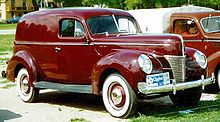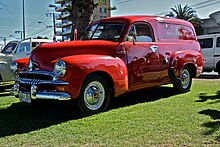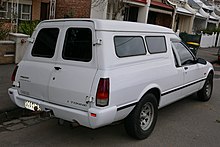User:NemoThorx/sandbox

A panel van (or panelvan) is a form of solid (rigid-bodied, non-articulated) van, smaller than a lorry or truck, without rear side windows. In the U.K. this body style is referred to as a "car-derived van" and in North American as a "sedan delivery".[1] In Australia panel vans were a development of the Australian "ute" (utility), a variety of pickup, based on a car chassis, these often utilising the floorpan of the station wagon model. In North America a two-door station wagon base was used with only front seats and steel sheet-metal panels in place of the rear and side windows.[2][3] Panel vans are widely used in many parts of the world for transporting cargo. In some national usages it is distinct from a purpose-designed van in that it is based on the chassis of a family car design. In places where they are distinct from a "van", they have less cargo space but better agility and maneuverability, making them particularly suited for cities with narrow streets or heavy traffic.
History[edit]
Tracing their roots back to the early days of automobiles, panel vans have historically been a part of major American car manufacturer's line-ups. Known as a "sedan delivery" in American English, it is a basically a two-door station wagon with sheet-metal panels in place of rear side doors and windows. Sedan deliveries have spartan interior trim and were used by businesses much as cargo vans are used today.
Every major European car manufacturer has a panel van in their line-up [citation needed]; these models used to be modified versions of existing passenger cars, such as the Citroën Visa-based Citroën C15 or the SEAT Ibiza-based SEAT Inca. This format was pioneered from the 1950s by the Citroën 2CV Fourgonnette and the Morris Minor. However, since the introduction of the Citroën Berlingo in 1996, it has become common for these vehicles to have a specific styling and structure, even if they may share chassis, powertrain or other components with passenger cars of the same brand. [citation needed]
Australia[edit]

Panel vans were first offered by Holden from December 1953 in the FJ model, and by Ford Australia from May 1961, based on the XK Falcon. Painters, electricians, and general labourers quickly found panel vans ideal for their trades, as the cargo bay offering extended capacity otherwise wasted in passenger space, and a highly customisable interior, without the bulk or extended dimensions of other longer-base vans. Australian police forces also purchased fleets of panel vans to use in a black maria, or paddywagon, role. These were known formally as Divisional Vans and in slang as Divvy Vans.
Concept[edit]
Most utes usually had an option of metal, then later rigid plastic, shells that would fit over the back of the tray of the ute, thereby extending the vertical space drivers could store in the tray, usually to just above the existing roofline of the passenger cab. Later shells offered plastic windows for ventilation along the sides and even pop-out or swing-out windows at the rear to aid the driver's rear vision. These became integrated into the body of the ute itself to form a panel van which integrated the passenger cabin with the cargo area soon developed a raised roofline, thus offering more rear space than a conventional station wagon with its rear seats folded down.
Initial models were fitted at the rear with swing-down and -up doors (like utes) and a low roofline (comparable to sedan and wagons), but soon evolved a higher roofline which increased available capacity, and improved internal access between cabin and storage areas. In the 70s Ford adopted a "barn-door" configurations that opened out to the sides of the vehicle, rather than down, aiding the loading of bulky freight into the vehicle without (as badly) damaging the body, though retained the traditional doors as an option through to the 80s. Passengers could climb from the interior passenger cab into the cargo bay behind them easily. Later the installation of safety cages which segregated passengers from the cargo area became popular to prevent freight from the back sliding into the passenger cab (and potentially injuring the driver).

By the early 1970s, at a time when the American panelvan was in decline, panel vans had become Australian cultural icons.[4] The Holden Sandman is probably the best-remembered of these: for example, one of the vehicles driven by Mel Gibson in the 1979 movie Mad Max was thought to be either a Holden Sandman or a customised Holden panel van (apparently a 1975 HJ model in both cases).[5] Ford panel vans (known briefly as Sundowners) were also popular, to a lesser degree. Chrysler also came to the party in 1976, offering a CL model Valiant panel van dubbed the Chrysler Drifter, but these could not compete with the popularity of Ford and particularly Holden, and were axed in 1978.
The final production of Holden's Sandman in the HZ series, featured a choice of V8 engines only, along with a four-headlight grille and under bumper front spoiler. According to a GMH Price List dated 25 January 1979, a basic HZ Holden panel van was priced at A$6,076, with the Sandman option package an additional A$1,700. The further optional components also included 5.0 litre V8 engine and a limited slip differential. If a buyer selected every Sandman extra, they would get a bonus velvet mattress with Holden logo embroidered. The price would be more than 150% of the cost of the basic HZ model. By the end of 1979, the Sandman had largely lost its place in the contemporary Australian youth culture - order figures were down and many of the vehicles were now being sold with the stripes and tailgate logos deleted. The Sandman ute was phased out of production prior to the van, the last of which was manufactured in October 1979.
In popular culture[edit]
Younger drivers were especially attracted to panel vans, for reasons such as the ease with which a mattress could be installed within the cargo bay. Consequently, panel vans also attracted nicknames such as "sin bins," "shaggin' wagons," "mobile virgin conversion units", "screw canoes," "Scooby-Doo mobiles" (after the Mystery Machine of the Hanna-Barbera animated cartoons), and "fuck trucks".[6] This kind of activity was frequently carried out at the local drive-in theatre. During the 1970s it also became fashionable to decorate the exterior sides with murals, often painted with intricate detail.[7] Along with the Volkswagen Kombi, panel vans were very popular with surfers (or wanna-be's), as it was convenient to sleep in the cargo bay during surfing "safaris", as well as carry boards and other equipment.
Decline[edit]

The popularity of panel vans waned in the 1980s. Holden's last release was their WB model. Subsequently, Ford became the sole manufacturer of them until 1999 when production of last entry in the history of the Australian panel van, the Ford Falcon XH model, ceased. In 2000, Holden unveiled a Sandman show car based on their Holden VU Ute of the time. This Sandman was never released, however from 2003 to 2005 an optional canopy in the same style was sold as panel vans, however they still retained the rear window and firewall of the ute they were originally based on, preventing movement between the cargo bay and the passenger cab, as offered by traditional panel vans.
Europe[edit]

In the past, deliveries were also popular in Europe. However, in the 1950s the larger sedan deliveries were replaced by vans like the Volkswagen Type 2, the DKW van and the first-generation Ford Transit. The smaller sedan deliveries continued; but now they are frequently replaced by small panel vans like the Renault Kangoo and the Opel Combo. Today, some station wagons like the Škoda Fabia, the Opel Astra or the final generation of the Ford Escort, can be ordered as a sedan delivery. There are also hatchback-based sedan deliveries like the Volkswagen Golf Mk2, the Volkswagen Polo Mk2, the Fiat Uno, the Peugeot 205, or the current Ford Fiesta.[which?] The Škoda Octavia Praktik was sold exclusively in Austria as unique example of Octavia as commercial sedan delivery.
Car-derived vans may still offer some advantages over station wagons or vans. Taxes may be lower on a car-derived van with steel panels instead of the glazed windows of the original station wagon with rear seating.[8] Speed limits for a car-derived van may be higher than a similar vehicle built originally as a van.[9] This has given rise to some anomalies, such as the first Citroën Berlingo model. As this was first sold in the UK as a van, it's counted as a van-derived car and so does not have the speed advantage, despite the two vehicles being otherwise comparable.
North America[edit]

Early models[edit]
Ford produced two vehicles, known as a "Town Car Delivery" and "Wood Panel Delivery", as part of its Ford Model A (1927–31) lineup.[10] Later Plymouth produced a sedan delivery from 1935 until 1941.[11] Pontiac produced deliveries until 1953 in the U.S. and until 1958 in Canada.[12] This was possible because Canadian Pontiacs of the 1940s and 1950s actually used Chevrolet bodies; in fact, they are known to have used the rear sections of Chevrolet bodies through 1954 (creating odd Pontiac-Chevrolet hybrids; Pontiacs from the firewall forward, but with Chevrolet tail-lights). It may be Canadian Pontiacs of the 1940s similarly were Chevrolets at the rear, with Pontiac sheet-metal and trim at the front. These models were usually produced in very small numbers (200 or less); 449 Canadian Pontiac sedan deliveries were built in 1958. The 1949-1952 Chevrolet sedan deliveries were attractive and dependable work vehicles. The 1957 150 series delivery is a valuable Chevy sought by collectors. From 1959 on, the sedan delivery was no longer practical; it was phased out in 1960 as a Chevrolet model, so the requisite Chevrolet body was no longer available.[13] Sedan deliveries were typically used as work vehicles, so they tended to wear out faster than a better cared for passenger car. With the growing sales of the Volkswagen Type 2 and the introduction of compact vans, sedan deliveries faded from the scene. Chevrolet dropped the body type after 1960, while Ford moved it to the Falcon line-up until 1965.[14]

1970s[edit]
Chevrolet and Ford offered subcompact sedan deliveries in the 1970s - The Chevrolet Vega Panel Express and the Ford Pinto Panel Wagon. The Vega Panel Express was introduced in September 1970.[15] It was Chevy's first sedan delivery in ten years since the 1960 final full-size model. Chevrolet offered the rare body style Vega (less than 2% of its production) for the 1971 through 1975 model years.[14] First year sales peaked at 7,800 units; After leveling off to 4,000 units per year, only 1,525 1975 models were sold.[16] The Pontiac Astre Panel, Pontiac's version of the Vega Panel Express, was available in Canada in the 1973-75 model years, and in the US for 1975.[12] The Pinto Panel Wagon was introduced in 1976 and was offered in both commercial and "factory customized" Cruising Wagon versions, featuring round port-hole rear side windows.[14] The Courier name, previously used for Ford sedan delivery vans, had been dropped and applied to foreign pickup trucks.
2000s to present[edit]

Chrysler showed a concept car edition of a sedan delivery based on the PT Cruiser at the North American International Auto Show in 2002, but it was not manufactured. In 2007 Chevrolet released a Sedan delivery version of the HHR, marketed as the HHR Panel.[17] In 2012, Ford of Europe introduced a Sedan Delivery configuration of the Ford Fiesta.[18]
Examples of the new wave of panel vans are the Renault Kangoo (1997), the Fiat Doblò (2001), Opel Combo (2001), Ford Transit Connect (2002) or the Volkswagen Caddy (2004). They are also purpose-designed to be utilitarian base model MPVs / people carriers, for a range of such vehicles. Due to economic crisis and strong shift on SUVs and CUVs, only two panel vans which are all-new models being released recently are Dacia Dokker (2012) and Ford Transit Connect (2013).
See also[edit]
References[edit]
- ^ "Car-derived vans and dual purpose vehicles - GOV.UK". GOV.UK. Retrieved 18 February 2018.
- ^ "Another look at sedan deliveries". Mac's Motor City Garage. 12 September 2013. Retrieved 18 February 2018.
- ^ Adams, Keith (25 September 2011). "Commercials : Car derived vans/pick-ups - AROnline". AROnline. Retrieved 18 February 2018.
- ^ Huynh, Mike (20 January 2015). "10 Most Iconic Australian Cars In Aussie Culture". D'MARGE. Retrieved 24 February 2018.
- ^ "1979 "Mad Max"/ 1975 Holden Sandman HJ - Best Movie Cars". Best Movie Cars. 25 April 2017. Retrieved 24 February 2018.
- ^ Byrne, Bob (18 October 2014). "The Shaggin' Wagon – Cars From Our Youth | Adelaide Remember When". www.adelaiderememberwhen.com.au. Retrieved 24 February 2018.
- ^ King, Poppy (12 April 2002). "Sex and art on wheels". www.theage.com.au. Retrieved 24 February 2018.
{{cite web}}: Cite has empty unknown parameter:|1=(help) - ^ {{Cite web|title=What is a car, commercial vehicle or motor home for VAT|url=http://www.hmrc.gov.uk/vat/sectors/motors/what-is-car.htm%7Cpublisher=HM Revenue & Customs (HMRC) }
- ^ "Speed limits and speeding". direct.gov.uk.
- ^ "Putting on the Ritz – The Model A Ford Town Car Sedan Delivery | The Old Motor". theoldmotor.com. July 31, 2014. Retrieved 18 February 2018.
- ^ Benjaminson., Jim. "Plymouth vans and delivery trucks". www.allpar.com. Retrieved 18 February 2018.
- ^ a b Jewell, Alden (November 25, 2014). "The Sedan Delivery". aldenjewell.com. Retrieved 18 February 2018.
- ^ 1960-61 Chevrolet Full-Line Truck brochures
- ^ a b c Halter, Tom (9 July 2017). "Automotive History: The Sedan Delivery". www.curbsideclassic.com. Retrieved 18 February 2018.
- ^ 1971 Vega brochure-Sept. 1970
- ^ h-body.org
- ^ Chevy introduces HHR Panel - Autoblog
- ^ "Ford Brings Back the Sedan Delivery – New Fiesta Van for Europe". The Truth About Cars, December 28, 2012.

